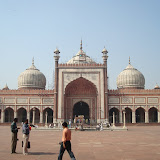 |
| Jama Masjid (Delhi 31 oct 2009) |
Saturday, October 31, 2009
Jama Masjid, Delhi
Shah Jahan, as his final architectural extravagance, built one of the largest mosques in India, Jama Masjid. Also known as Masjid-i-Jahan Numa, it was the principal mosque of the Emperor. Owing to its huge size, it took six years to be fully complete. Situated on a high platform, the austere, yet beautiful, building was built in red sandstone, with extensive use of white marble. The pulpit of Jama Masjid has been beautifully carved out of a single block of marble. It has three gateways, four soaring towers and two minarets. The 130-ft high slender minarets of the mosque grace its impressive façade. The eastern gate was once reserved for the Emperor. Wide staircases and arched gateways greet the visitors of the mosque. The relics of the Prophet and the Holy Koran are enshrined here and its courtyard can hold up to 25,000 worshippers at one go. Designed by Ustad Khalil, the great sculptor of his time, it was built at an astounding cost.
Red Fort, Delhi
Shah Jahan shifted his capital from Agra to Shahjahanabad and laid the foundation of Red Fort, or the Lal Quila, on 16th April 1639. It took 9 years to build this mighty citadel and it got completed on 16th April 1648. It is said that about one crore rupees, an astronomical sum in those days, was spent on its construction. Half of this sum was spent to build the exotic palaces within the fort. Built of red sandstone, it is octagonal in shape, with two longer sides on the east and west. The perimeter of its strong ramparts is about 2.41 km. Red Fort rises to a height of 33.5 m on the town side and 18 m along the river. A wide moat surrounds the fort, which was originally connected with the river and was always filled with water. The two main gateways, known as Lahori Gate and Delhi Gate (named so, as they face Lahore and Delhi respectively), are three storeys high and are flanked by semi-octagonal towers.
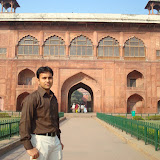 |
| Red Fort(Delhi 31 0ct 2009) |
Raj Ghat, Delhi
Raj Ghat, the cremation site of Mahatma Gandhi is one of the most visited sites in Delhi. It consists of a simple square black-marble platform that stands on the spot where Mahatma Gandhi was cremated. Raj Ghat is situated to the south of Red Fort and is very peaceful. The black marble tomb is inscribed by the words 'Hey Ram!', the last words that were spoken by Mahatma Gandhi, as he fell down after being shot by Nathuram Godse. The whole edifice of the Samadhi reflects the simple and nature-loving personality of the great leader. The cenotaph stands surrounded by earthworks that protect it from the flooding of the Yamuna. These walls have resulted in the open space of the memorial being converted into an enclosed garden.
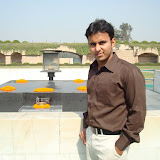 |
| Raj Ghat (31 0ct 2009) |
Thursday, October 29, 2009
India Gate,Delhi
The war memorial arch, India Gate, was built by the British in the honor of the unknown martyrs, who lost their lives in the First World War and Second Afghan War. Originally known as All India War Memorial, it has the names of the soldiers who died in the wars inscribed on its walls. Since 1971, there is the eternal soldier's flame burning under it, known as 'Amar Jawan Jyoti'. It is said that Edwin Lutyens and Herbert Baker designed India Gate and its surrounding area. India Gate is situated on Rajpath (the Royal Road). It is the ceremonial boulevard of the Indian republic that boasts of ornamental parks, pools and gardens alongside. It is here that the much-awaited event of Republic Day Parade takes place on 26th January every year.
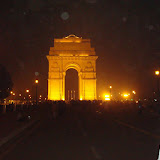 |
| India Gate(Delhi 29 0ct 2009) |
Sunday, October 25, 2009
Pearl Valley, Annekal, Karnataka
Pearl Valley, Bangalore is a tourist destination that is frequented by large numbers of people annually. Located at a distance of about 44 kilometers from Bangalore, this place is a well-known picnic spot in the area. The greatest attraction of this place is the cascading waterfall, which falls from an altitude of about 300 meters. Pearl Valley in Bangalore is a welcome respite from the humdrum of modern life. Located in a quiet and tranquil environment, Pearl Valley is enclosed by many big and small hills and mountains. The place is secluded from the other areas and makes a great picnic destination. There are also some animals that can be found in the Pearl Valley, Bangalore. The name Pearl Valley at Bangalore has been derived from the fact that, when the water falls from a great height and strikes the ground, it scatters like drops of pearls. This is a beautiful sight and with the sunrays glistening on the water drops, the sight becomes all the more spectacular.
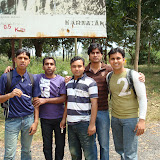 |
| Pearl Valley (25th oct 2009) |
Sunday, October 11, 2009
Savandurga, Karnataka
Savandurga is 61 Kms from Bangalore near Magadi and yet another spot enjoyed by the trekkers. Savandurga is a hill with a fortress which was the hideout of Kempe Gowda.The hills are about 4000 feet high (1300 meters) and is known for its green landscape, thickets, and cool environment on top of the hills. Billi Gudda or White Hill is easier to climb of the two. An overgrown shrub path starts near the temple at the base of the foothills. There are white paint marks that serve as indicators for the path to climbing the hill; it soon disappears after a while. Thick Bamboo bushes and throny shrubs greet you along the way. Karigudda is supposed to more dangerous to trek than BiliGudda and should not be attempted by amateur trekkers and climbers. Savanadurga is part of the granite hill range of Ramanagaram and are great spot for a quick getaway from Bangalore on regular days or on weekends.
 |
| Savandurga Trek (11th oct 2009) |
Subscribe to:
Posts (Atom)